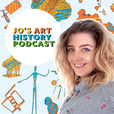
Summary: <p>It’s episode 26 of Jo’s Art History Podcast! Well, I have an incredibly fascinating episode for you all this week! Today, I sit down with artist and perfumer of the people, Michael Borkowsky to talk about the history of perfume and WHY this is an art form in itself. From magical positions for everlasting youth to bottling the scent of the new modern day woman, Michael takes us on a whistle stop tour on the art of perfume through the ages. Only discovering and falling in love with the art and practise of making perfume few years ago, it has taken Michael on an incredible journey of history and alchemy which has now intertwined into his artistic practise. What is even more interesting though is perfume has always held an important place within different societies throughout the history of the world. This is an incredibly interesting chat with Michael and we also mention his absolutely brilliant series on youtube called ‘Plague for Plague Sake’ which you can find a link to in the show notes below! Michael has an incredibly interesting practise so please do check him out below: Guest: Michael Borkowsky Artist & Perfumer of the people! Instagram: https://www.instagram.com/mborkowsky/ Website: https://www.michaelborkowsky.com/ Contact: borkowskyart@gmail.com Michael runs Frontier Gallery: https://www.instagram.com/fronteer_art/ Michael’s Series Plague for Plague’s sake: https://www.instagram.com/mborkowsky/channel/ Notes from Michael at a glance & Further reading: Tapputi the Chemist (1200 BC) - Tapputi is considered to be one of the worlds first perfumers. She used flowers and herbs local to Egypt and combined them with water and solvents which were subsequently filtered. Her perfume making process and use of local materials has informed a facet of my own work, whereby I have made fragrances using Sheffield's river water in order to evoke a sense of place. As an aside, Egypt was also the country that founded the idea of the perfume bottle, which in itself is steeped in history. Short Video on the History of Tapputi: https://www.youtube.com/watch?v=baHU3GL2J-Y Article on the history of Tapputi: https://www.thevintagenews.com/2018/10/29/tapputi/ Hungary Water (1370-1470 AD) - One of the first alcohol-based perfumes created in Europe, Hungary Water has somewhat dubious origins but was thought to be created by an alchemist-Monk as a possible means to cure Queen Elizabeth of Hungary's headaches. As such, it's an example of how perfume was used as medicine. This provided me with inspiration to create a video series, entitled 'Plague for Plague's Sake', that sees me recreate some somewhat dubious historical plague cures by utilising the art of perfumery. Lush - History of Hungry Water: https://uk.lush.com/ingredients/queen-hungary-water Hungary Water Wiki Page: https://en.wikipedia.org/wiki/Hungary_water Victorians and Flowers (1850 - 1900) - While the idea that flowers have symbolic meaning has been recognised for centuries, it was popularised by the Victorians, where deciphering the meanings became both a pastime and a way of sending messages. The idea that scent can be a means of communication highlights how perfume can be an art form. The Language of Flowers: https://bit.ly/36Dnkgl What did Victorian Ladies Smell like: https://bust.com/style/19232-a-victorian-lady-s-guide-to-perfume.html Chanel No 5 (1921) - Chanel No 5 was created by the perfumer Earnest Beaux in 1921 for Gabrielle 'Coco' Chanel as a means of appealing to the progressive feminist attitudes of 1920's women. Beaux offered Chanel 10 vials of scent, and her favourite was the 5th vial, hence the name Chanel No 5. Chanel also believed she had something of an affinity with the number 5, which may have influenced her decision. The narrative of how Chanel No 5 came about is a story of collaboration, superstition and artistry which influences my...</p> <p><br></p> --- Send in a voice message: https://podcasters.spotify.com/pod/show/jos-art-history-podcast/message
